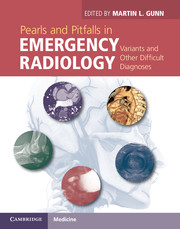Book contents
- Frontmatter
- Contents
- List of contributors
- Preface
- Acknowledgments
- Section 1 Brain, head, and neck
- Section 2 Spine
- Section 3 Thorax
- Section 4 Cardiovascular
- Section 5 Abdomen
- Case 50 Simulated active bleeding
- Case 51 Pseudopneumoperitoneum
- Case 52 Intra-abdominal focal fat infarction: epiploic appendagitis and omental infarction
- Case 53 False-negative and False-positive FAST
- Liver and biliary
- Spleen
- Pancreas
- Case 59 Pseudopancreatitis following trauma
- Case 60 Pancreatic clefts
- Bowel
- Kidney and ureter
- Section 6 Pelvis
- Section 7 Musculoskeletal
- Section 8 Pediatrics
- Index
- References
Case 59 - Pseudopancreatitis following trauma
from Pancreas
Published online by Cambridge University Press: 05 March 2013
- Frontmatter
- Contents
- List of contributors
- Preface
- Acknowledgments
- Section 1 Brain, head, and neck
- Section 2 Spine
- Section 3 Thorax
- Section 4 Cardiovascular
- Section 5 Abdomen
- Case 50 Simulated active bleeding
- Case 51 Pseudopneumoperitoneum
- Case 52 Intra-abdominal focal fat infarction: epiploic appendagitis and omental infarction
- Case 53 False-negative and False-positive FAST
- Liver and biliary
- Spleen
- Pancreas
- Case 59 Pseudopancreatitis following trauma
- Case 60 Pancreatic clefts
- Bowel
- Kidney and ureter
- Section 6 Pelvis
- Section 7 Musculoskeletal
- Section 8 Pediatrics
- Index
- References
Summary
Imaging description
Missed pancreatic injuries result in considerable morbidity and increased mortality [1]. Unfortunately, evidence suggests that multidetector CT (MDCT) is of suboptimal sensitivity for the detection of pancreatic parenchymal and duct injury [1, 2]. One of the signs of pancreatic injury is peripancreatic fluid. In particular, fluid between the pancreas and splenic vein is suggestive of injury [3]. However, intrapancreatic and peripancreatic fluid has been observed in trauma patients who have no other signs or symptoms of pancreatic trauma at all [4].
Pseudopancreatitis appears as peripancreatic and intrapancreatic low density, resembling fluid (Figure 59.1). The pancreas may appear swollen. Other findings that support pseudopancreatitis include periportal low density (edema) within the liver, distension of the inferior vena cava (IVC), and small bowel edema.
Direct signs of pancreatic injury, such as lacerations or areas of hypoperfusion of the pancreas, are absent. Lacerations can be simulated by pancreatic clefts, which tend to be smooth and linear, and have rounded margins. Clefts may contain small penetrating vessels, and they do not traverse the full width of the glands.
Because the peripancreatic space is continuous with the extraperitoneal space in the pelvis, fluid can surround the pancreas as an extension of extraperitoneal pelvic fluid arising from pelvic fractures, extraperitoneal bladder rupture, or pelvic arterial injury.
- Type
- Chapter
- Information
- Pearls and Pitfalls in Emergency RadiologyVariants and Other Difficult Diagnoses, pp. 194 - 195Publisher: Cambridge University PressPrint publication year: 2013

